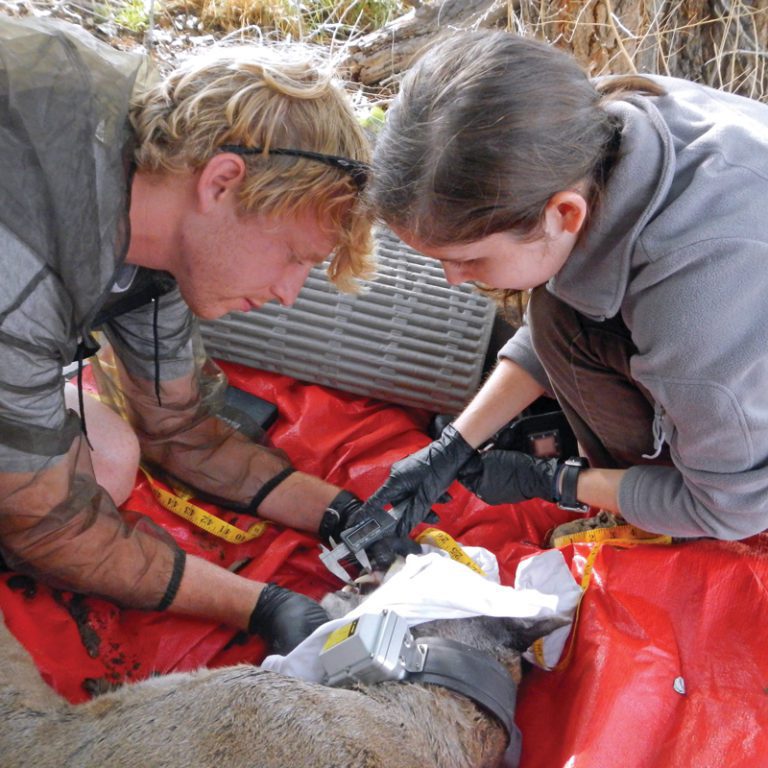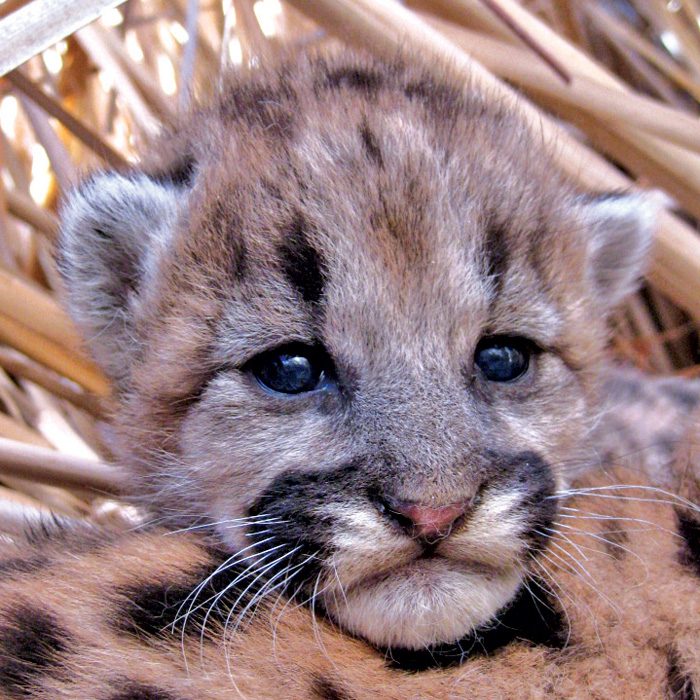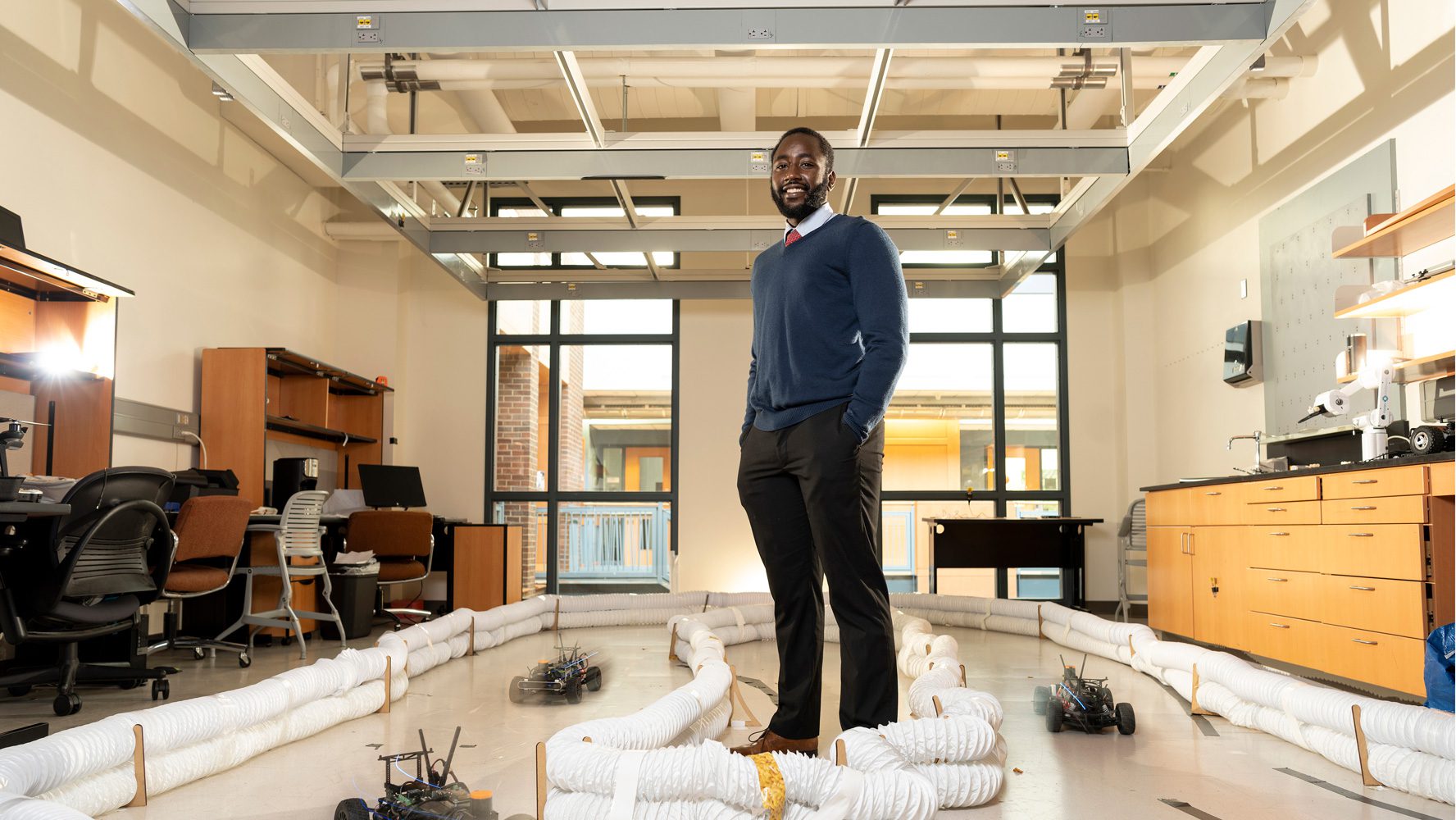
Feature
For the Love of Lions
The Furman Cougar Project gives undergraduates a rare opportunity.
By Ron Wagner ’93
Furman Professor of Biology Travis Perry ’92 and his students have studied mountain lions as part of Perry’s Furman Cougar Project for more than a decade. They’ve also studied pumas, panthers and catamounts.
Furman Professor of Biology Travis Perry ’92 and his students have studied mountain lions as part of Perry’s Furman Cougar Project for more than a decade. They’ve also studied pumas, panthers and catamounts.
If you’re confused as to how one wildlife biologist and a handful of undergraduate researchers could juggle studying this many animals at once, it helps to understand that the mountain lion, puma, panther catamount and cougar are actually the same animal: Puma concolor. “And in the Rocky Mountain West,” Perry adds with a chuckle, “it is simply referred to as ‘lion.’”
Mountain lions have so many identities because their range is the largest of any mammal in the western hemisphere, and that has brought them into contact with an array of human civilizations over the centuries. At one time, mountain lions could be found from the Atlantic to the Pacific in both North and South America as well as all the way to the southernmost tip of Chile and north to British Columbia and Quebec.
“It was everywhere. As a result, we have lots of common names for the same cat,” Perry says. “(Scientists) use those names interchangeably, maybe three different ones in the same sentence.”
The vast distribution is the result of the animals’ incredible ability to hunt and adapt. In addition to being legendarily elusive, mountain lions, which are the second-largest cat in the Americas after the jaguar, can weigh up to 200 pounds and possess physical abilities that defy belief. No other cat can leap 40 feet from a running start or spring 15 feet straight up. Mountain lions also can sprint up to 50 mph, carry prey four times their weight, and travel astonishing distances. One young male was confirmed to have moved from the Black Hills of South Dakota to Connecticut – about 1,800 miles – before being killed by a car.

Travis Perry ’92 with the third male puma his team captured and collared on their large private ranch study site. Fifty-eight Furman students participated in these capture-and-data-collection events. More than a dozen Furman students have used the data from this collared cat for independent research projects and presentations at professional conferences.
But over the past 100 years, not even mountain lions have been able to withstand the pressure of human extermination efforts and habitat destruction. Outside of Florida, which has a genetically distinct and federally protected small population, there hasn’t been a confirmed sighting of the eastern mountain lion since 1938. In 2018, it was officially declared extinct in that half of the United States.
Such a fate doesn’t seem imminent in the West, where state game agencies estimate there are 20,000 to 40,000 animals. But the numbers are a broad estimate, and that’s where Perry and his team come in. Their work tracking mountain lions in western New Mexico’s Sierra County is contributing to the overall understanding of the species, which
hopefully will help us more precisely calculate their numbers.
“The central question that my research program is trying to answer is, ‘How do we get accurate, cost-effective estimates of mountain lion population size?’” Perry says. “In terms of mountain lion conservation, that is the single most important thing, because if we don’t know how many there are on the landscape, then we can’t make sensible decisions and policies.”
Humans are directly responsible for 3,000 mountain lion deaths annually, and the lack of empirical data is reflected in a patchwork of state regulations ranging from “specially protected mammal,” which can’t be hunted for sport (California), to “varmint” that can be killed without limitation (Texas). Those inconsistencies leave open the potential for a dangerous decline in their numbers.
The Furman Cougar Project has been chipping away at the information shortage since 2007, with Perry taking a small group of students to one of the more rugged and remote areas in the United States every summer (with the exception of 2020 because of COVID-19 travel restrictions) to immerse themselves as much as possible into the cats’ world. They spend their days in a variety of ways, from hiking miles in the punishing southwestern summer heat to download images from a network of 25 remote cameras, to examining what remains of kills, to sitting at computers following mountain lion movements. The latter is possible because of the rarest but most-anticipated thing the researchers do: capture, which happens once or twice a summer.
“What is an exciting animal that I really wanted to work with since I was a kid but I always kind of thought that I never could? Big cats.” ”– Furman Professor of Biology Travis Perry ’92
“Awe-inspiring,” Jesse Woodsmith ’13 says. “There is nothing like it to see one in front of you. The first mountain lion we captured was a relatively large male, and when you’re opening a mountain lion’s mouth to measure its teeth, it’s pretty hard to not think about the amazing opportunity you have that very few people get to do.”
Perry has captured 33, and it’s serious business. In addition to being a dangerous moment for the humans involved, it is essential the animals not be harmed while they’re trapped and sedated to be weighed, measured and fitted with GPS collars.
“If you’re going to be injured by a mountain lion, it’s 1,000 times more likely when you are forcing a direct interaction with the animal,” Perry says. “There’s a tremendous amount of safety training and instruction and a very tightly controlled scene when we do have a capture.”
The information they gain is invaluable, as is the help Perry gets from students in obtaining it. The limited scale of the Furman Cougar Project takes it out of consideration for large grants, but having a nearly unparalleled opportunity is motivation enough to make it work with smaller grants and donations.
“Big-cat research is a rare thing in general, and it’s exceptionally rare for undergraduates to be able to participate directly in big-cat research, which is one of the reasons I developed the program – to give Furman students something unique,” Perry says. “They can answer small, undergraduate-sized questions year after year after year, and I can continue to build the amount of data I have for these longer-term studies and these larger questions.”

Furman students, Richard Pickens ’12 and Scarlet Sellers ’14, collect data on the Bosque del Apache national wildlife refuge in southern New Mexico.

A cub produced by a collared female puma on the refuge. Measuring population parameters such as birth rates and death rates is one of the research objectives of Perry and his students.

A very healthy 4- or 5-year-old cat’s teeth and gums. The shape and condition of the teeth allow researchers to determine the animal’s age, while gum color and capillary refill offer information about the animal’s health.
Woodsmith got an early and intense dose of research with Perry, spending summers after both her first and second years at Furman participating in the Cougar Project, sandwiched around the “Wild Semester” of study Perry also leads in New Mexico. She calls them the “most impactful experiences” she had at Furman.
“I just don’t know of any equivalent program or transformative experience that really anybody gets to go through that early in college,” says Woodsmith, who is now the director of conservation and stewardship at the Southern Conservation Trust.
After graduating from Furman with a biology degree and earning a Ph.D. from the University of New Mexico, Perry spent 15 years studying bats before deciding, at what he then considered to be the midpoint of his career, that it was now or never to do something different.
“‘What is an exciting animal that I really wanted to work with since I was a kid but I always kind of thought that I never could? Big cats,’” Perry remembers thinking. “There are multiple objectives. Research is just one. Educating students and educating the public are equally important. I think I’ve certainly gained a much greater appreciation for (mountain lions). Apart from the strict science, I feel like I know them.”
Support student research with the Furman Cougar Project. furman.edu/giving


